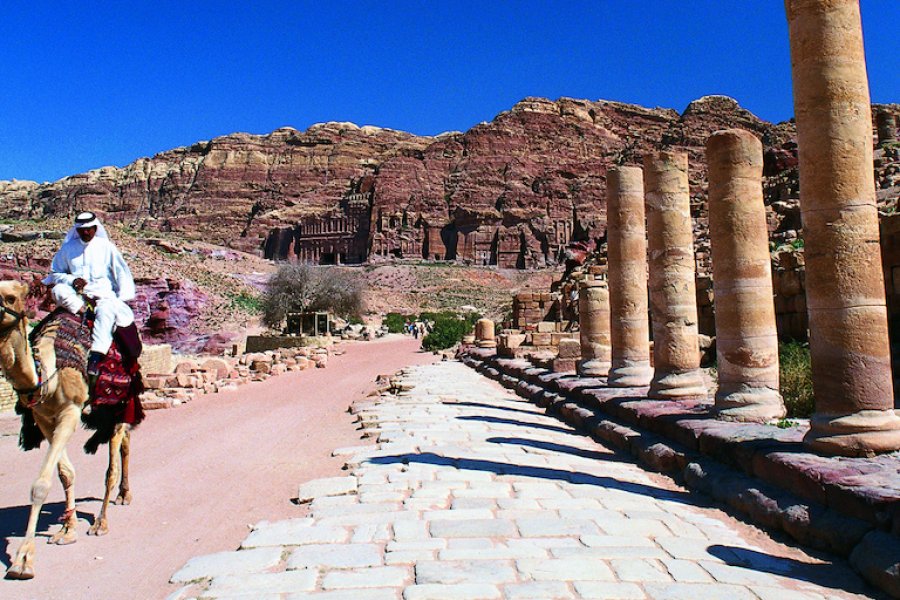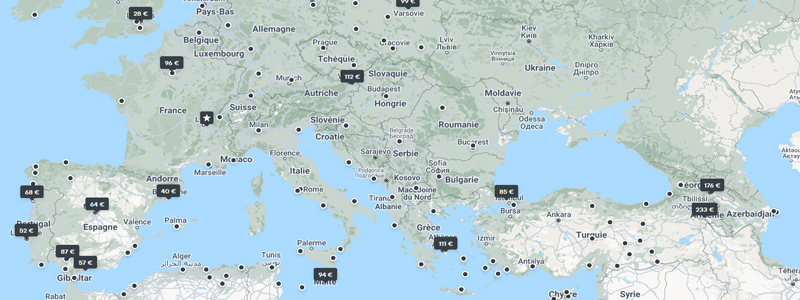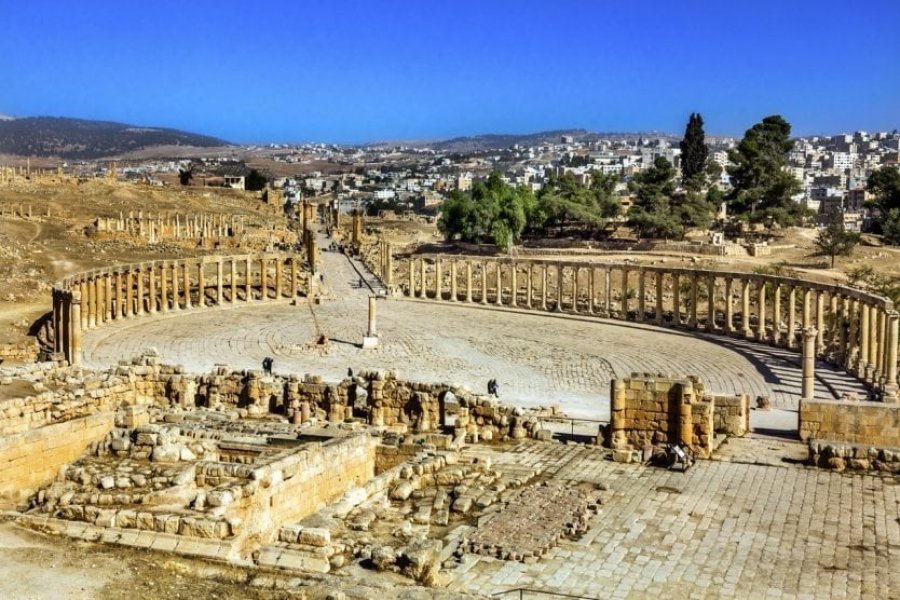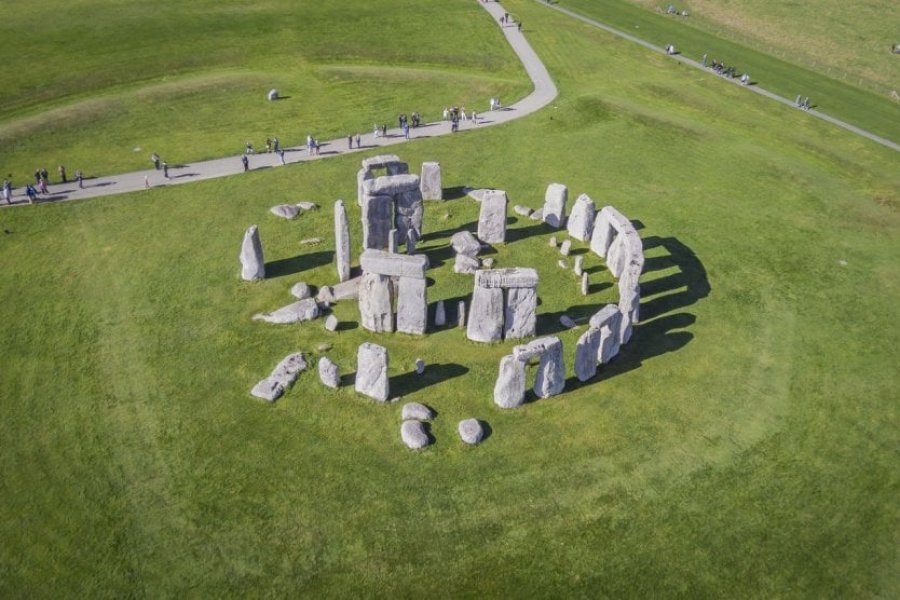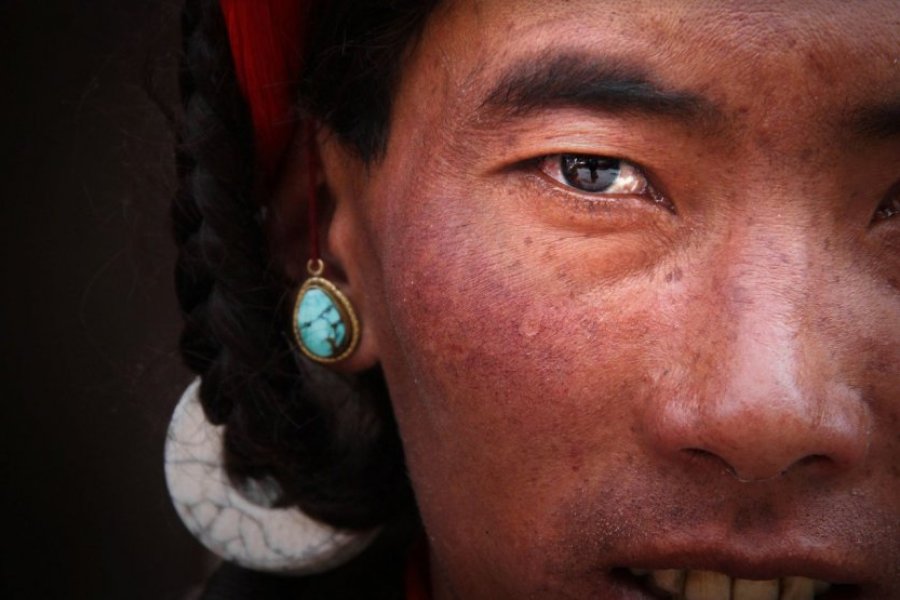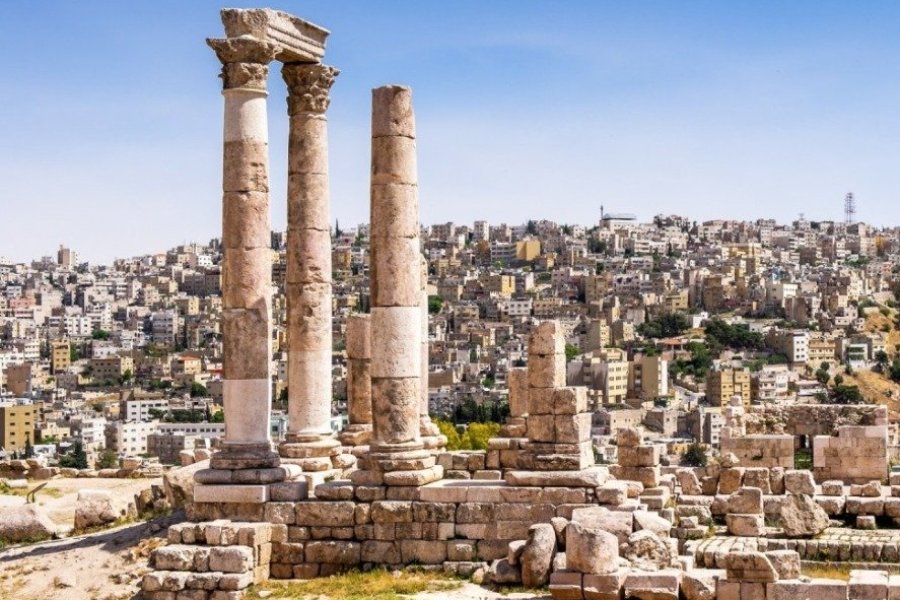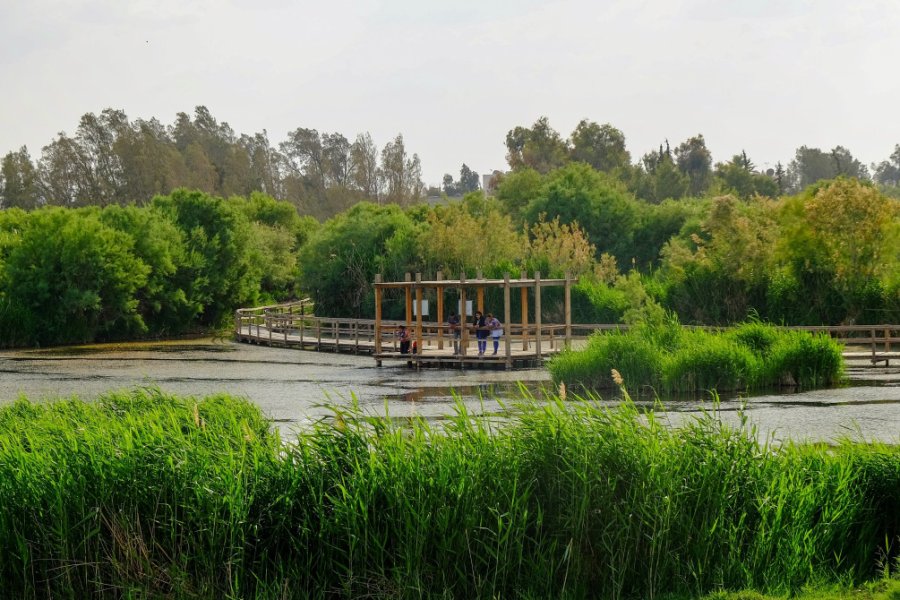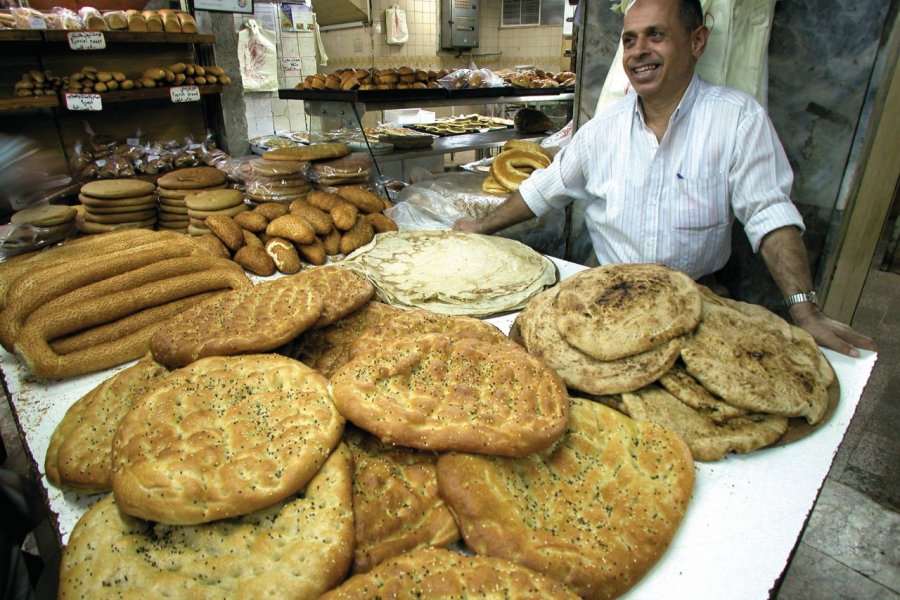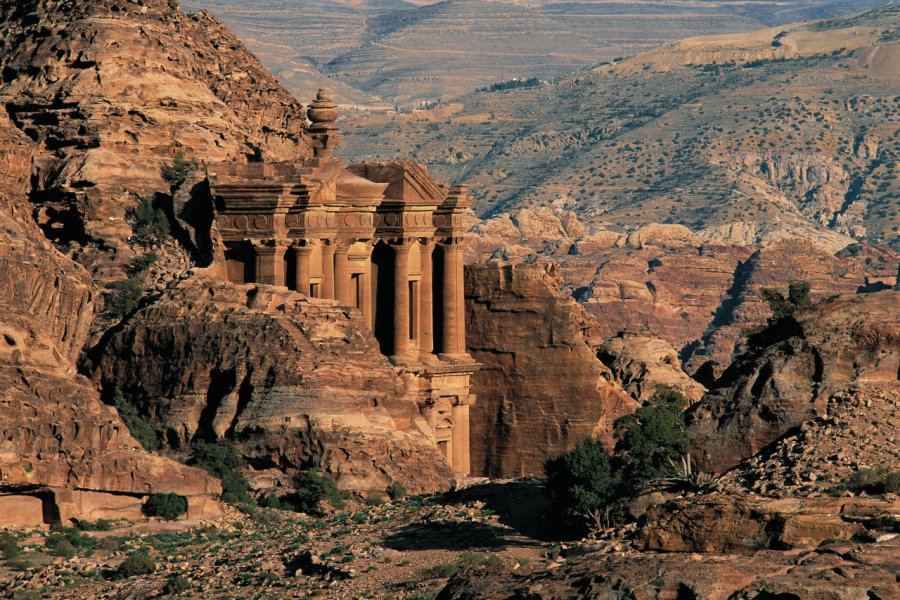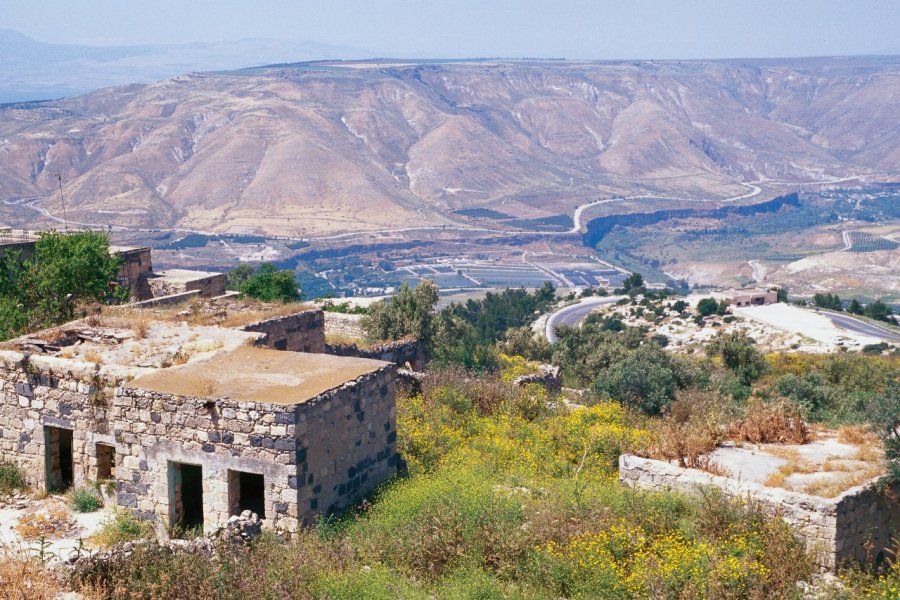Travel guide Jordan
Quietly nestled in the Middle East between the Red Sea and the Dead Sea, Jordan awaits travelers with the sweetness of a mint tea. Sometimes rocky or desert, green or sandy, Jordan's landscapes are distinguished by their diversity. A trip to Jordan is guaranteed to be a beautiful journey surrounded by canyons, cliffs and natural arches, from the panoramas of Wadi Mujib, the "Grand Canyon of Jordan", to the fabulous desert of Wadi Rum, watching the sunset on the hill of the ancient fortress of Masheron. The opulent civilizations that succeeded each other in these extraordinary lands have left behind them architectural wonders that will stay with you for a long time thanks to your Jordan tour guide: the hidden city of Petra, the last stage of Indiana Jones' quest for the Holy Grail, Jerash, the Jordanian Pompeii, or the desert castles east of Amman. And to recover from all these emotions, what better way than to go diving in the ever-warm waters of the Gulf of Aqaba ?
What to see, what to do Jordan?
-
Book an activity
-
Customized travel
- The most beautiful cities Jordan
When to go Jordan ?
The best times to visit Jordan are in the spring and fall, when the weather is mild throughout the country. The Ramadan period is not ideal, but not completely inadvisable either, as is the case for other Muslim countries. While many services and restaurants remain closed all day in Jordan, signs indicate which ones are still open for tourists, non-Muslim expatriates, or Muslims traveling exempt from fasting.
Suggested addresses Jordan
Travel Jordan
-
Find a hotel
-
Car Rental
-
-5% on travel insurance-15% off travel insurance
-
Find a local agency
La Jordanie est un petit pays, mais tellement magnétique et attachant que l'on peut prévoir d'y passer un long week-end, comme plusieurs semaines. L'essentiel du pays, avec ses incontournables tels que Petra, Jerash ou le Wadi Rum, se parcourt en une semaine, sans trop se presser. Les mordus de randonnée, de contemplation au milieu des déserts et les compulsifs de ruines antiques prévoiront le double ou le triple, pour être sûr de prendre le temps et de ne rien rater. Moins réputée pour le tourisme religieux que son célèbre voisin Israël, la Jordanie compte tout de même plusieurs sites bibliques d'importance. Le lieu de baptême du Christ est sans conteste le plus important, mais les somptueuses mosaïques des églises de la période byzantine ou les ruines de la forteresse de Machéronte où fut exécuté Jean-le-Baptiste, le sont tout autant. Le pays présente l'avantage d'allier culture, nature et histoire en parcourant de courtes distances.
Find unique Stay Offers with our Partners
How to go Jordan
How to go alone
There are several airlines offering flights to Jordan. The flights have for destination Amman and are numerous to be direct. The journey takes about 4h30. Royal Jordanian Airlines also provides a link to Aqaba. Please note that the price variation depends on the airline used and, above all, on the reservation deadline. In order to get good prices, it is essential to book well in advance. Remember to buy your tickets six months before departure!
How to go on a tour
As the main tourist sites are relatively concentrated, agencies offer one-week guided tours that allow you to avoid missing out without wasting time (Petra, Aqaba, Wadi Rum, Jerash, desert castles, descent to the Dead Sea...). Others organize hiking/trekking tours on a smaller scale in Wadi Rum or the Rainbow Valley.
How to get around
There is only one domestic air service, between Amman and Aqaba. Otherwise, the most economical way to get around the country is by bus or minibus. They cover the entire country and no village is left out. Large cities are connected with each other by regular services, which is not the case with small towns, located in sparsely populated areas, such as in the east of the country. Unlike buses, minibuses do not leave at a fixed time, but when the vehicle has filled up with passengers.
Featured articles Jordan
Discover Jordan
With its immemorial history - traces of human presence date back 500,000 years - Jordan has managed to find a peaceful place in a tormented region. The country was built from scratch on the ruins of an Ottoman Empire divided by the British and French powers. It has forged its identity on Arab identity, Bedouin traditions and the practice of open Islam. The richness of its culture is expressed in the ancient remains of Petra and Jerash, as well as in the Bedouin tradition of hospitality. The harshness of its landscapes contrasts with the constant generosity and smiles of its inhabitants. This small country, poor in natural resources, seduces with the grandeur of its soul and the feeling of eternity that emanates from its deserts. History, nature, culture, social life and gastronomy are just some of the facets to be explored for a foretaste of what awaits you.
Pictures and images Jordan
The 12 keywords Jordan
1. Coffee
Coffee is, for Jordanians, an important cultural symbol of hospitality. In Bedouin tradition, three rounds of coffee are offered first (one for the soul, one for the sword, and one in honor of the host), followed by tea. By accepting the coffee offered to you, you in turn signify your benevolence.
2. Chai
Tea arrived in the region with the British. It is traditional to welcome visitors with a glass of sweet tea. In the south, the Bedouins flavor their tea with wild sage gathered from the desert. In restaurants, you are more likely to be served mint tea. In the roadside stands, a plain tea.
3. Decapole
At the time of the emperor Alexander the Great, ten cities were federated in the heart of a Decapolis intended to develop trade between the East and the West. Roads were built as well as temples, theaters, fountains, palaces... Their remains form today an exceptional testimony that one never tires of surveying.
4. Falafel

The dumplings made of chickpea flour flavored with herbs, garlic and onion are the delight of Jordanians... at breakfast. Thus, the best falafels are eaten in the gargotes that open at dawn. Of course, you can eat them at any time of the day, preferably in a sandwich, crushed in an unleavened bread cake.
5. Hashemite
The Hashemite Kingdom has existed since 1946, but the origin of the reigning royal family is thousands of years old. It is descended from Hashim ibn Abdel Manaf, great-grandfather of the Prophet Mohammed. This family was the guardian of Mecca until the arrival of the Saud. It is composed of several branches. Thus, the pretenders to the throne of Iraq are Hashemites.
6. Jebel

These are the hills or mountains in Arabic. The ancient city of Amman was built on seven hills that made historians say that it was the Rome of the East. The Jordanian desert is made up of rugged mountains in the hollows of which man has erected magnificent sites such as Petra, or which nature has divided into sumptuous wadis.
7. Keffieh

The keffiyeh is a square scarf folded into two triangles and held on the head by two knotted strings. Bedouins use it as protection against the sun and sand. The traditional Jordanian keffiyeh alternates red and white checks. The keffiyeh is also a sign of tribal recognition. The patterns change depending on the tribe.
8. Mansaf
Jordan's national dish traditionally consists of lamb cooked in fermented and dried goat's milk called jameed. Mansaf is served with rice, almonds and pine nuts. This heritage of Bedouin tradition is the dish of special occasions: wedding, birth, guest of honour, Eid... and it is eaten with the fingers!
9. Qasr
The qasr, or "castles", are part of Jordan's historical landscape. These fortresses are found in the northeast of the country and on the Kings' Highway, and date for the most part from the Arab Umayyad dynasty. They were placed at strategic points, at the edge of the desert or on busy caravan and pilgrimage routes.
10. Sheesha
One does not smoke hookah in Jordan, one "drinks a sheesha" to use the literal translation of the country's dialectal Arabic. Until recently, coffee lovers could choose between molasses or apple flavors. Now, an explosion of flavors perfumes the country's coffees: apricot, melon, cherry, flowers, cappuccino or even cola..
11. Shibriya
The Bedouin dagger is known as a shibriya. All men carry this traditional dagger, as it symbolizes virility. It consists of a short blade curved in a double edge and often engraved. The handle is made of horn and the richly carved wooden sheath is equipped with a belt loop and is worn on the back side.
12. Wadi

The wadi designates both a watercourse and a valley. They are often dry and form sandy beds that the Bedouins use to move around. But storms and rains can suddenly and violently fill them, transforming them into destructive torrents. They are also the result of geological evolutions as in Wadi Rum.
You are from here, if...
You overuse polite phrases and call your interlocutor "habibi" (which means "darling").
Shake hands with everyone in a room when entering or leaving.
You avoid addressing a woman directly when you are a man
You eat with your right hand. The left hand is reserved for impure activities, such as personal hygiene.
You take off your shoes before entering a house.
You wear "decent" clothing, avoiding shorts for men, cleavage and short clothing for women
You accept the tea or coffee offered to you, take the time to discuss with your host and return the empty cup.
You help yourself to a dish several times, the best compliment you can give to the hostess
You are careful about bringing up the Arab-Israeli issue. Half the population is of Palestinian origin and the subject is highly sensitive. It is best to avoid the subject at all costs.

